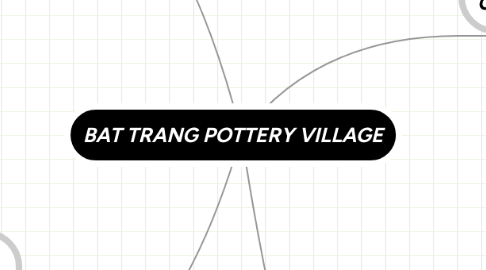
1. FESTIVAL
1.1. Time
1.1.1. On the 15th day of the 2nd month of the lunar year
1.1.2. Normally lasts for 7 days
1.2. Place
1.2.1. In communal house
1.2.1.1. A common house for all villagers
1.2.1.2. Worship 6 genies - first clans settled and forming Bat Trang village
1.3. Ceremonies
1.3.1. Water procession
1.3.1.1. A boat is dispatched out to the Red River to take water into a "Bat Trang" jar, which later is used to wash the sacred tablets. At midstream, a member of the Nguyen Ninh Trang family has the honour of scooping river water into the jar
1.3.2. Games
1.3.2.1. Human chess, cock fighting, singing poems,etc.
2. HISTORY
2.1. In 1010, Ly Thai To relocated the captial to Dai La
2.1.1. Craftmen immigrated
2.1.2. Handicraft were formed inside/on the outskirt of the new capital
2.2. In 14th-15th century, Bat Trang is said to be established by people from Thanh Hoa province
2.3. By the end of 14th century, China prohibited individuals trading overseas
2.3.1. Bat Trang enjoyed a wider market of ceramic wares in Southeast Asia
2.3.2. Bat Trang products were selected as tributes to the Ming court
2.4. In 15th-16th century, policies to encourage cottage industry and trading were launched
2.4.1. Bat Trang became prosperous
2.4.2. Products were various and widely distributed
2.5. In 17th century, commercial relationship was established with Japan
2.5.1. Large quantities of ceramic wares were imported to Japan
2.5.2. Bat Trang reached its peak of development
2.6. By the end of 17th century, a close-door policy was applied
2.6.1. Many ceramic export centers were collapsed (Chu Dau wares)
2.6.2. Bat Trang export pottery declined but remained famous thanks to larged domestic market
2.7. Since 2000, open-market economy
2.7.1. Bat Trang's cottage industry has been revived
2.7.2. More decorative products are produced rather than just kitchen wares
3. CHARACTERISTICS
3.1. Products
3.1.1. High quality with unique glazes (cracked glaze/ white-blue glaze)
3.2. Village's infrastructure
3.2.1. Tiny land area due to yearly erosion by Red River
3.2.1.1. For both living and ceramic production (workshop, drying yards,etc.)
3.2.1.2. House densely packed side by side
3.2.1.3. Not enough land for burying the death
3.2.2. Streets
3.2.2.1. Zigzag shape
3.2.2.2. Many blind alleys to avoid thieves
3.2.3. Walls
3.2.3.1. Made of famous Bat Trang bricks
3.2.3.2. 2 layers and empty in the middle
3.2.3.2.1. Make house stronger
3.2.3.2.2. Warm in winter, cool in summer
3.2.3.3. Old time: keep money/treasure in brick hole inside the wall
3.3. Local lifestyle
3.3.1. As an agricultural villages, the living standard is relatively high
3.3.2. High community sprit
3.3.3. A sense of protection of their professional rights
3.3.3.1. Production process is specialized to individual groups/ trade guilds
3.3.3.2. Each clan has their own products, no copy
3.3.3.3. Craft secret (glaze making) is passed on to the son only
4. PRODUCTION PROCESS
4.1. Clay preparation
4.1.1. Clay treatment and Mixing
4.1.1.1. Remove impurities and leave a deep layer of clay ideal for making pottery
4.1.2. Shaping
4.1.2.1. Traditional method: shape on the potter's wheel by hand
4.1.2.2. Most popular method: use mould made of plaster
4.1.3. Drying and Correcting
4.2. Glazing pottery
4.3. Firing
4.3.1. Use box kiln with 5m high,0.9m wide & lined with resistant bricks
4.3.2. Time firing: 3 days and 3 nights
